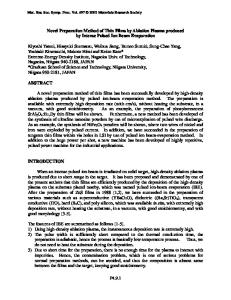Characteristics of Polycrystalline Silicon thin Films Prepared by Pulsed Ion-Beam Evaporation
- PDF / 809,656 Bytes
- 6 Pages / 612 x 792 pts (letter) Page_size
- 14 Downloads / 366 Views
CHARACTERISTICS OF POLYCRYSTALLINE SILICON THIN FILMS PREPARED BY PULSED ION-BEAM EVAPORATION Sung-Chae Yang, Ali Fazlat, Hisayuki Suematsu, Weihua Jiang and Kiyoshi Yatsui Extreme Energy-Density Research Institute, Nagaoka University of Technology 1603-1 Kamitomioka, Nagaoka, Niigata 940-2188, Japan ABSTRACT Using intense pulsed ion-beam evaporation technique, we have succeeded in the preparation of polycrystalline silicon thin films on silicon substrate without impurities. Good crystallinity and high deposition rate have been achieved without heating the substrate. The crystallinity of poly-Si film has been improved with increasing the density of the ablation plasma. The intense diffraction peaks of poly-Si thin films can be obtained by using the substrate bias system. The crystallinity and the deposition rate of poly-Si thin films are increased by negative bias voltage for the substrate. INTRODUCTION The preparation of polycrystalline silicon (poly-Si) thin films has received much attention due to their wide applications for a semiconductor in thin film transistors (TFTs), solar cells, peripheral circuits of liquid-crystal displays, and electrodes in Si-integrated circuits. Conventionally, poly-Si films were prepared by a plasma-enhanced chemical vapor deposition
℃
(PECVD) method with postannealing (~800 ) of a-Si:H films or substrate heating (200 400 ) [1-3]. This technique requires high temperatures and long time for the processing. Since such a high temperature limits substrate materials or fabrication process. For practical engineering applications, furthermore, very low deposition rate is a serious problem for achieving high throughput of electronic devices, such as solar cells. For this purpose, several types of low-pressure and high-density plasma sources have been applied to increase the crystallinity and the deposition rate of poly-Si thin films such as inductively coupled plasma (ICP), surface wave plasma (SWP), ultra high-frequency (UHF) plasma, and electron cyclotron resonance (ECR) plasma. However, the deposition rates are typically 0.5 – 4 nm/s [2-6]. If the pulsed proton beam irradiates solid targets, high-density ablation plasma can be
℃
~
produced due to short range of protons in targets. Using such the plasma ( 1018/ cm3), it has been found out to prepare thin films very efficiently with high deposition rate ( cm/s), which P5.15.1
~
was called as intense, pulsed ion-beam evaporation (IBE) [7-10]. In the present paper, we report the characteristics of poly-Si thin films prepared at room temperature, i.e., without heating the substrate, by a high-density ablation plasma produced by IBE. The crystallization and the deposition rate of poly-Si thin films prepared at different substrate positions are investigated. Furthermore, the effect of substrate bias voltage on the crystallinity and the deposition rate will be discussed. EXPERIMENTAL APPARATUS AND METHOD Figure 1 shows the schematic of the experimental arrangement. The light ion beam (LIB) is produced by a geometrically focused, magnetica
Data Loading...





